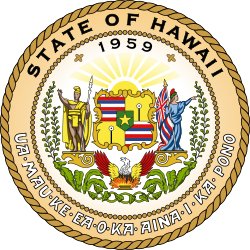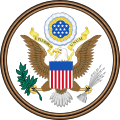| Great Seal of the State of Hawaii | |
|---|---|
 | |
| Versions | |
 Seal of the Territory of Hawaii | |
 Seal of the Republic of Hawaii | |
| Armiger | State of Hawaii |
| Adopted | 1959 |
| Motto | Ua Mau ke Ea o ka ʻĀina i ka Pono "The life of the land is perpetuated in righteousness" |

The Great Seal of the State of Hawaii was designated officially by Act 272 of the 1959 Territorial Legislature and is based on the territorial seal. [1] Modifications to the territorial seal included the use of the words "State of Hawaii" at the top and "1959" within the circle. Provisions for a seal for the state of Hawaii were enacted by the Territorial Legislature and approved by Governor William F. Quinn on June 8, 1959. [2] The passage of the Admission Act in 1959, admitted Hawaii as the 50th State of the United States of America on August 21, 1959.
Contents
- State Seal
- Coat of arms
- Supporters design
- Crest design
- Motto design
- Compartment design
- Symbolism
- Government seals of Hawaii
- See also
- References
- External links
The seal of the Territory of Hawaii was the same as the seal of the republic, except that it had "Territory of Hawaii" placed at the top and "1900" (signifying the year that the territorial government officially was organized) within the circle. [1] The 1901 Territorial Legislature authorized the modified republic seal as the Seal of the Territory of Hawaii. [2]
The seal of the Republic of Hawaii had the words "Republic of Hawaii" at the top and "MDCCCXCIV" within the circle. The year 1894 signified the date that the republic was established. [1] The republic seal was designed by Viggo Jacobsen, a Honolulu resident, and itself was derived from the Royal Arms of the Kingdom of Hawaii used during the reigns of King Kamehameha III, King Kalākaua and Queen Liliʻuokalani, which had been designed by the College of Arms in London in 1842 and officially adopted in 1845. [3]
- Royal Arms of the Kingdom of Hawaii as designed by the College of Arms
- Version of the Royal Arms later adopted by the Kingdom around 1870
- Version used in the Provisional Government






